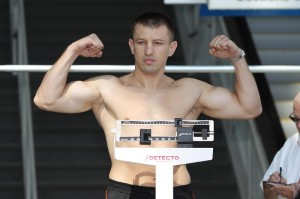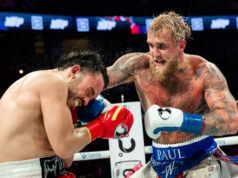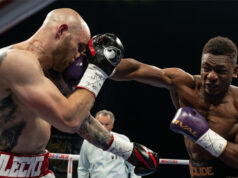The conventional wisdom is that heavyweights have been getting steadily bigger over time, and there is something to that notion. Rewind to the 1930s, and the 6’2″, 218-lb Max Baer was considered a big heavyweight. Evander Holyfield is about the same size as Max Baer, although today he would only be considered of only average size. The division always had exceptions, of course, but most heavyweights were typically about six feet tall and weighed in between 190 and 200 lbs well into the mid-1960s. It was during the Golden Age of the division, the era of Ali, Foreman and Frazier, that things began to change. During that era, more and more of the heavyweight top ten was made up of men who weighed between 215 and 220 lbs and often stood 6’2″ or 6’3″.
Why Heavyweights Got Bigger
That shift was natural enough, because the 1960s saw the Baby Boomers come of age. As any competent anthropologist will tell you, the average size within a group of people is tied directly to sustained diet. A population that enjoys a consistent, healthy and ample food supply will start to get larger over successive generations. Studies show that during the Revolutionary War, the typical American was a full two inches taller than the English, Irish, Scottish and German troops who were sent over to fight him. Contrast the typical, modern South Korean, who has enjoyed relative affluence since the 1950s, with the tiny North Koreans living across the border. Before Americans started getting fatter all the time, we were a nation of people who were always getting taller. The Baby Boomers in particular were a generation who enjoyed plenty, so naturally the generation produced a bumper crop of out-sized boxers.
That has produced bigger heavyweights. As previously mentioned, there were always giants standing out among the ranks of the big men of boxing. The 1930s had Primo Carnera (6’6″) and the lesser-known Jose Soares Santa (6’9″). Ernie Terrell was a 6’6″ Golden Age giant, although he was perhaps most famous for being the recipient of a thrashing at the hands of Muhammad Ali in the famous “what’s my name!?” fight. The problem with these big guys was that, like Nikolai Vaulev today, their size advantage was a dubious one. They had height, reach, and sometimes sheer strength. However, they were awkward fighters who were unable to effectively translate their bulk into real punching power. Carnera, for example, was more of a thudding puncher than a cracking, concussive one. Also, their sheer lack of mobility made them standing targets for anyone who could get inside those long, clumsy arms, and their very size sometimes led to stamina problems. The modern era continues to produce similar “super heavyweights” of limited ability, such as the aforementioned Vaulev, Lance Whitaker, Michael Grant, Alexander Dimitrenko and Lou Savarese.
Big Guys in the Modern Era
What makes the current generation and the previous generation of heavyweights so different is that they have managed to produce a couple of super heavyweights each who combined real talent with great size. The previous generation had Riddick Bowe and Lennox Lewis, and the current generation has the Klitschko brothers. No one would described any of these boxers as plodding heavies who rely only on their size. However, their existence has led to two grossly mistaken generalizations. First is the “bigger is always better” idea, which is easily disproved by examining the records of the aforementioned limited-but-giant heavyweights. Size alone does not guarantee anything in the heavyweight division. Anyone who thinks otherwise should review Dempsey vs. Willard, when a 6’1″, 187 lbs Dempsey savagely felled the original super heavyweight, the 6’6″, 245 lbs Jess Willard.

Another false conclusion is the idea that modern heavyweights in general are bigger than their forebears of the recent past. In my recent article Golden Age Heavyweights vs. Modern Heavyweights, one of the points that should have been clear was how most heavyweights from 2005, 1995, 1985 and even 1975 are all basically the same size. Take a look at the Heavyweight Top 10, for example. WBA Champion David Haye, Tomasz Adamek, Alexander Povetkin, Ruslan Chagaev and Eddie Chambers are all heavyweights whose size would be unremarkable if they had fought at any point in the last 40 years. Fighters like Chris Arreola and the unranked Sam Peter are of completely normal height, but greatly inflated weight, and that extra weight is from a mix of weightlifting bulk and fat. Of the current Top 10, only the Klitschkos and Tony Thompson are true super heavyweights, and Thompson may yet prove to be a limited fighter.
The facts bear out that the only remarkable difference in terms of size between the heavyweights of today and those of the last four decades is that there are finally enough men of truly huge proportions around the world that a tiny handful – exactly four by my count – brought a mix of towering size and athleticism to the heavyweight division. Perhaps boxing would have more talented super heavyweights were it not for the NFL, but that is speculative. The rest of the division is made up of men who are about 6’2″ or 6’3″ and weigh around 220 lbs, and some top fighters who are even smaller. In the past, these men have always produced fighters who posed a substantial threat to even the most talented of super heavies.
In terms of what this means for the modern heavyweight division, we know that Vitali Klitschko (and most likely Wladimir as well) are not objectively better than Lennox Lewis. Ergo, the only conclusion one can draw about the modern division is that it has two good super heavyweights and a crop of (thus far) second-tier normal heavyweights, rather than the very talented yet normal-sized heavies of the past. That scenario does not indicate that today’s heavyweights are ” bigger, faster and stronger” than their forebears, let alone intrinsically better.










